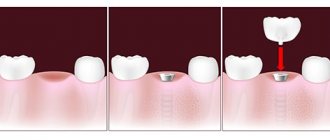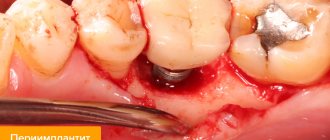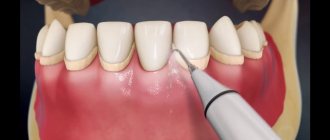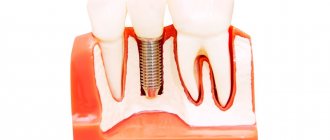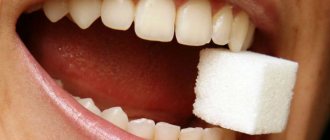Almost any dental procedure, including dental implants, is traditionally performed using local anesthetics. However, the usual “freezing” is not sufficient in all cases. Dentophobia, increased gag reflex, allergies to anesthetics and a number of other factors become an obstacle to treatment. For some patients, dental implantation under general anesthesia may be the only chance to restore the integrity of the dentition. Modern clinics use safe drugs, and pain relief and treatment are carried out strictly under the supervision of an anesthesiologist.
Types of pain relief
In dental practice, different anesthesia is used:
- local - tissue anesthesia in the area of the operation, it can be infiltration, conduction, application;
- sedation - putting a person into a state of sleep or half-asleep, can be deep, superficial, medium, does not suppress the central nervous system;
- general anesthesia - putting the patient into an unconscious state, deep medicated sleep.
When choosing a method, the indications, the scale of the operation and contraindications are taken into account.
Premedication – assistance with anesthesia before dental implantation
Premedication is a course of taking medications aimed at calming the nervous system (central and peripheral) in conjunction with anesthesia. For example, if a large-scale operation is planned to install a large number of implants, the patient already experiences strong anxiety and fear during the examination, and the anesthesiologist calculates a course of premedication. 1 - 2 days before the proposed operation, the patient takes sedatives, for example, valerian infusion, Seduxen, Glycised and others.
Advantages of dental implantation in a dream
The procedure is absolutely painless. During treatment, a person does not see, hear or feel anything. After waking up, he does not remember anything about what is happening, so no psychological trauma occurs.
The doctor is not distracted by the patient’s reactions, which means he can concentrate entirely on his work. This minimizes the risks of medical errors and the development of subsequent complications. The procedure is completed faster and the implants are placed more accurately.
As clinical practice shows, the harm from severe stress is much greater than from possible negative reactions to drugs. During a strong emotional experience, painful shock, a sharp jump in blood pressure, and heart problems may occur. Anesthesia eliminates such phenomena.
Features of the procedure
Titanium is considered the most preferred material for prosthetics. It takes root well in bone tissue and quite rarely provokes allergies and other complications. Due to these advantages, the material is often used to replace teeth. The design is a kind of titanium root screwed into the bone through a previously cut gum.
Service life of implant parts
On the root there is an artificial tooth, consisting of an abutment, crown and implant body. Dental implantation is carried out only under anesthesia and consists of several stages:
- The patient is given an anesthetic.
- After this, the specialist makes a small incision in the gum.
- The next step is to drill a hole in the bone and insert a special plug into it, into which a titanium root is screwed.
- Next, the gum is sutured and the patient visits the doctor after 2 weeks.
Engraftment of the root takes from 2 to 3 months, depending on the individual characteristics of the organism. The type of anesthesia is determined by a specialist.
Indications and contraindications
The patient himself can choose the method of anesthesia, but the doctor decides whether its use is available.
There are medical indications for treatment under anesthesia:
- strong fear of implantation, dental phobia;
- patients of the older age group;
- installation of more than three implants at the same time;
- a complex, lengthy operation, for example, the collection and installation of donor bone during bone grafting;
- increased gag reflex;
- Parkinson's disease;
- diseases of the central nervous system;
- allergic reactions to local anesthetics.
The list of contraindications includes severe pathologies of the kidneys, liver, alcohol or drug intoxication, previous stroke and myocardial infarction (for six months), exacerbation of bronchial asthma, pathologies of the thyroid gland, treatment with hormonal medications, heart failure.
Content
- Types of anesthesia
- Implantation under anesthesia
- Implantation under general anesthesia
- Minuses
- Side effects
To implant an implant, anesthesia is required in any case, since a deep incision of soft tissue is made and work with bone tissue is performed. Dentists have many options when it comes to choosing the best anesthesia. It is cheaper and easier to use local anesthesia. As a rule, high-quality local anesthesia is the optimal measure when installing up to four implants.
The best and safest option is articaine anesthetics - modern drugs of medium action, providing a sufficient duration of anesthesia for most dental practices.
The most preferred agents for local anesthesia are articaine (ultracaine) and scandonest.
PROMOTION
Osstem dental implantation turnkey
18,000 rub.
Types of drugs for implantation under anesthesia
The anesthesiologist decides what means are used to put a person into medicated sleep after examining the patient. It excludes contraindications, calculates the dosage and duration of anesthesia. The doctor is present during the procedure and monitors the patient’s vital signs.
For general anesthesia the following is used:
- Sevoran. One of the most powerful and safe drugs. Quickly puts a person to sleep. Does not have an unpleasant odor and does not cause allergies. A minimal list of contraindications, can be used in childhood, for mental disorders.
- Xenon. It is an inert gas without taste, smell, or color. Absolutely harmless to health. Can be used at any age. It is quickly eliminated from the body and does not require long-term rehabilitation.
- Foran. It is inexpensive, but has a sharp, unpleasant odor. To ensure psychological comfort, the patient can be given Sevoran in the first minutes, and then anesthetized with Foran. Effective for procedures lasting no more than one and a half hours.
The list of drugs is wider. At the consultation stage, the doctor tells the patient about the advantages and possible complications of available painkillers.
Types of anesthesia used
In medicine, pain relief is called sedation. Today, various techniques are used to ensure comfortable manipulation. The most popular types are local, combined and general anesthesia. Each method has its own advantages and disadvantages.
Based on the results of the examination, the specialist determines the possibility of using one or another method. The level of pain threshold plays an important role, since there is a group of patients who do not respond to local anesthesia even with minimal intervention. The other part can undergo the procedure without the use of general anesthesia. After determining the method of sedation, it is allowed to proceed directly to implantation.
Local anesthesia
Thanks to this method, the negative effects of drugs do not spread to the central nervous system, as with general anesthesia. There are several types of local effects:
- Superficial - is the simplest and safest method, when an anesthetic in the form of a spray is applied to the required area. The medicine quickly eliminates sensitivity, and the doctor can begin the procedure. The disadvantage of this method is the minimum exposure time. Among other things, there is a group of patients who do not respond to such pain relief.
- Infiltrative - considered the most popular variety. It consists of the introduction of an anesthetic that affects sensitive nerve endings for no more than 60 minutes and is called “freezing”. After the set time, the effect gradually weakens over 30-50 minutes, depending on the individual characteristics of each patient. This method is used not only during implantation, but also during filling or tooth extraction.
- The conduction method is also popular and its mechanism of action resembles the infiltrative one. The anesthetic is administered locally, but its action is aimed at blocking the nerve endings that surround the site of the intended impact. Thanks to this, the area becomes isolated and the patient does not feel pain. The disadvantage of the technique is that during the administration of the drug, the specialist cannot always accurately determine the location of the nerves, since it may be slightly different for each patient.
- Trunk anesthesia is not used as often as previous methods. It involves injecting an anesthetic into the base of the skull. From there, the effect spreads to the trigeminal nerve of the jaw. It is considered a fairly effective method.
Several years ago, Lidocaine was used for local sedation, but today Ultracaine is most often used. The drug contains a similar active substance, but is considered more effective. The dose is determined strictly individually.
The most serious disadvantage of this method of anesthesia is considered to be the high risk of developing allergic reactions to the drug.
Combined anesthesia
This type of sedation is most often used for patients with a low pain threshold, as well as chronic vascular and cardiac pathologies. The essence of the method is the administration of a local anesthetic and simultaneous infusion of sedatives. This technique is also allowed if you are allergic to certain medications.
Thanks to the complex effect, the patient does not feel pain, and his nervous tension is eased. The effect on the brain with this method is minimal; the effect of the medicine lasts from 3 to 10 hours, depending on the dosage of the drug. A significant advantage is the ability to use the method for children.
The received doses of drugs are quickly eliminated, which reduces the risk of negative effects on internal organs. After the procedure, the patient does not need much time to recover, which is also considered an advantage of this method. The cost of combined sedation is affordable, and the effectiveness is quite high.
General sedation
The essence of the method is to administer drugs that put the patient into a kind of sleep. He does not feel pain, which allows the specialist to carry out the teeth replacement procedure. As a rule, this technique is used for those who have a low pain threshold, allergies to local anesthetics, and serious vascular pathologies. An indication is also the lack of effect from the use of Ultracaine and its analogues.
During the procedure, an anesthesiologist must always be with the patient to monitor his condition. The most popular drugs for general sedation are the following:
- Sevoran is one of the safest. It acts quickly and allows the patient to instantly wake up after the end of the manipulation. Used for children because it rarely provokes allergies. It is well excreted by the body and reduces the likelihood of negative reactions from internal organs.
- Foran - used for sedation during procedures that take at least 90 minutes. However, it is quite rarely used without Sevoran in small quantities.
- Xenon is a tasteless and odorless gas. Suitable for adults and children. It is considered safe for the body, is quickly eliminated and rarely provokes negative reactions.
After choosing an anesthetic, the specialist calculates the dosage, which will be different in each individual case. It is worth noting that implantation under general anesthesia has contraindications, including the following: severe heart failure, recovery period after a stroke or heart attack, thyroid pathologies, bronchial asthma, kidney and liver diseases in an advanced stage.
If the patient is taking any hormonal medications, it is necessary to warn the specialist about this, since complications may arise when using general anesthesia. For patients with diabetes mellitus and arterial hypertension, the doctor adjusts the dosage of antihypertensive and hypoglycemic drugs before the procedure. This is considered a necessary condition to ensure that the procedure does not provoke adverse reactions.
How is dental implantation performed under anesthesia?
Before starting treatment, the patient undergoes the necessary diagnostic examination. It is mandatory to take blood tests for general indicators, coagulation, levels of glucose, bilirubin, cholesterol, AST, alkaline phosphatase, hepatitis, syphilis, HIV. A urine test is also required. If there are heart pathologies, permission from a cardiologist is required. If there is an allergy to medications, the patient should tell the doctor about it.
Before implantation, the anesthesiologist puts the patient into medicated sleep. Once the person is asleep, a speculum is inserted into the mouth and the surgeon begins the operation. During the procedure, he monitors the body’s condition using special equipment. Up to ten indicators are displayed on the monitor. If necessary, changes the dosage of the drug.
When all dental procedures are completed, the gas supply stops and the patient wakes up. He has been in the clinic for some time. Once your health has stabilized, you can go home. It is necessary to worry about an accompanying person in advance, as dizziness, decreased concentration, and weakness are possible.
Prohibitions on anesthesia during implantation
Risk group of patients with a clear need for significant anesthesia during surgery:
- severe liver and kidney disease;
- recent (less than 6 months ago) myocardial infarction;
- the presence of serious cardiovascular pathologies;
- impaired blood circulation in the vessels of the brain;
- recent infectious diseases;
- post-stroke rehabilitation period;
- bronchial asthma in the acute stage;
- serious dysfunction of the endocrine system;
- completing a course of taking hormonal drugs;
- rehabilitation course after an injury;
- pregnancy and breastfeeding.
The listed contraindications indicate that administering anesthesia is a serious decision that a specialist makes after weighing all the pros and cons of the anesthetic procedure.
Dental implantation under sedation using ZAX and intravenous drugs
For a shallow, superficial immersion in a state of half-asleep, anesthesia with nitrous oxide is used. Laughing gas is administered through a nasal mask and works almost immediately. The person feels relaxed, fear and anxiety go away, and he can hear the doctor and perform simple actions. The action ends after gas is supplied.
Intravenous sedation is carried out using the drugs Propofol or Dexdor. After injection into a vein, the person falls soundly asleep. He does not react to what is happening, and after waking up he does not remember the procedure. The method is suitable for multiple implantations, for example, restoration of dentition with complete edentia. It is necessary to strictly control the dosage of the drug.
When is sedation necessary?
- performing bone augmentation in the upper and lower jaw;
- installation of up to 8 implants in the jawbone during one visit to the surgeon;
- increased sensitivity of teeth and gums;
- surgical intervention that takes more than two and a half to three hours;
- undesirable use of general anesthesia according to objective indicators.
During the process of sedation, the perception of reality is slightly dulled, but the client is able to answer the doctor’s questions and perform certain movements.
Cost of installing dental implants under anesthesia in Moscow
The cost of general anesthesia depends on the price of the drug and its duration of action. Treatment with anesthesia with Sevoran will cost 7,500 rubles per half hour of use. Sedation with Propofol or Dexdor costs around 4000 for the same time. Application of ZAX for 30 minutes - 1500 rubles.
The FamilySmile clinic uses different types of anesthesia: local, intravenous or inhalation sedation, anesthesia. Pain relief is carried out only with safe, high-quality drugs. The service is provided by a qualified anesthesiologist with extensive experience.
We provide any dental services: prosthetics, implantation of lost teeth, professional oral hygiene, extraction, restoration, whitening, teeth straightening, treatment of caries, periodontitis, gingivitis, bite correction. Pre-registration is made by telephone.
When is anesthesia prescribed for dental implantation?
You cannot do without anesthesia during the operation of introducing a foreign component into the oral cavity in the following cases:
- reduced pain threshold in a patient who does not respond to local anesthesia;
- individual intolerance to local painkillers;
- the presence of an involuntary gag reflex when surgical instruments are in the oral cavity;
- combination of “hypertension + increased excitability” and fear of mechanical impact on the jaw.
Progress of the operation
- Putting the patient into deep sleep.
- Gum incision.
- Implant installation.
- Stitching.
For complete engraftment of titanium roots, it takes 3 to 6 months, during which the patient must strictly follow the surgeon’s instructions. After the doctor is convinced of the successful implantation, the dental technician begins making the crown or crowns. They are installed on the artificial root using so-called abutments, which are adapter clamps.
Technologies of prosthetics on implants
In Moscow, the service is increasingly in demand. It attracts not only its effectiveness, but also its low invasiveness - the most gentle surgical intervention. In implantology, classical prosthetic methods are inferior to innovative ones with fewer supports. The most popular methods are All-on-4 and All-on-6.
All-on-4 . The most economical method of implantation. Developed and patented by Nobel Biocare in Switzerland.
It involves the implantation of 4 titanium roots into the jaw with simultaneous loading. Two implants are placed in the front part of the jaw in parallel with natural teeth. Two more are implanted in the area of 5-6 premolars at an angle of 30-45° to the base.
The scheme for placing the roots ensures their stable fixation, allows you to do without bone augmentation, and perform prosthetics without delay.
All-on-6. The technology was proposed by Nobel Biocare. It involves the implantation of 6 support rods with instantaneous loading into the jaw. According to their location, they are implanted similarly to the All-on-4 technique. Moreover, 4 implants are installed in front of the jaw.
All-on-6 implantation is more reliable. With it, the adhesion of artificial materials to biological ones is higher.
The technique is usually used to restore the upper dentition. It is indicated for use in restoring lower teeth when the bone is not dense enough.
Complete dental prosthetics with implants for injuries, diseases, and pathologies is possible with the implantation of 4 or 6 titanium rods into the jaw. Both methods are applicable and allow you to restore your teeth for 20 years or more. Still, we recommend the second option because of its greater reliability. Our dentists use different techniques and high-quality materials. The treatment course may take up to one year. It is possible to accurately plan treatment, its timing and cost only after an examination.
Possible complications after general anesthesia
It should be said right away that the use of general anesthesia always causes some complications. This is a completely normal phenomenon, and you should not be afraid of them. The patient may experience discomfort while recovering from general anesthesia. Let's name them.
- A mild sore throat and dry mouth may be present for two days after surgery.
- For the first half hour after surgery, slight tremors may be observed in the body.
- The effect of general anesthesia is always accompanied by a decrease in blood pressure. Because of this, after waking up, the patient may feel dizzy and experience bouts of nausea.
- Some patients may experience itching. Its appearance is associated with a mild allergic reaction to medications.
- Older people may experience confusion during recovery from anesthesia.
- In rare cases, the patient awakens before the operation is completed. The reason for this is the anesthesiologist’s mistake when choosing the drug or its dose.
All of the above complications do not always occur and not in all patients. Their manifestation is associated with the individual characteristics of each person’s body.
General overview of the operation
It’s not without reason that titanium material is used to implant inside the jaw bone: it performs excellent functionality and does not cause allergies. An artificial tooth is an element that consists of three parts:
— the implant itself is similar in appearance to a simple threaded bolt. They are made from bioinert titanium alloys;
- abutment - an intermediate element of an artificial tooth, which is attached to the implant and is the basis for attaching the crown;
— dental crown — there are several techniques for installing implants.
For example: examining the mouth and preparing it for placement of an artificial tooth. They perform fluoroscopy of the jaw, sanitation of the cavity, selection of the type of implant, and hygiene.
At the preparation stage, the fact may come up that the jaw bone is very narrow and requires its extension (bone grafting).
Placement of the implant is possible only with local anesthesia. Composition - creating accessibility to the area of placement (removing the periosteum), drilling a hole for an artificial root, screwing in an implant, placing a gingival former.
Prosthetics – the former is removed, a transfer will replace it, an impression is made, an abutment is selected, a crown is fixed and correction is carried out. The abutment is secured to the implant after the outermost element has healed to the bone tissue. And this will take more than one month (three to four for the lower jaw, five to eight for the upper).
Important! Placing an implant - engraftment (osseointegration), placing an abutment and crown - is a long period, it can take about a year.
Progress of setting up an artificial tooth:
- administration of painkillers;
- cutting the gums;
— a hole is drilled into the bone into which the titanium root will be screwed;
— a plug is screwed into the fixed root, the gum is sutured.
After three weeks, the client's gum sutures are removed. The entire period of engraftment of a titanium root will require two to three months. Then it’s time to remove the plug. Instead, the uppermost element of the product is installed, finally resembling the configuration of the tooth. Over the next couple of weeks, the gums are completely healed. The time has come to make an impression for the future crown. After manufacturing, it is installed together with the abutment. That's it - the implantation procedure is completed. The client becomes the owner of a new, super-strong, aesthetic tooth.
Anesthesia is a need or desire of the client. For most dental patients, it is important that they do not feel a bit of pain during the procedures. Everyone has a different pain threshold, so the type of anesthesia should be considered with the client.
There are cases when local anesthesia is not effective, general anesthesia comes to the rescue. But its use is possible only by those clinics that are licensed for this procedure.
Types of anesthesia
In scientific language, pain relief is called sedation. It can be partial or complete. Each technology has its advantages and disadvantages, which the doctor must warn the patient about in advance. Modern dentistry uses a variety of methods, but most often the anesthetic is injected directly into the area where the dentist is working.
The possibility of using medications for pain relief is determined based on a thorough preliminary examination of the patient. First of all, the doctor clarifies whether a person has allergic reactions, as well as the degree of his sensitivity (the so-called pain threshold). Unfortunately, there are cases when even a local injection does not help get rid of discomfort during surgery.
Other patients, on the other hand, can cope with major surgery with mild pain relief. After the specialist decides which drug to use, you can set a date for installing the implant. Careful preliminary preparation will make the process comfortable for both the patient in the dental chair and the doctor himself.
Operation duration
It is installed by the operating surgeon together with the anesthesiologist-resuscitator. Directly depends on the volume of bone tissue, the condition of soft tissues in the working field, the number of implants planned for installation on the day of surgery, and the need for tooth extraction. Approximate boundaries:
| Scope of work | Hours of sedation |
| 1 implant | 1 hour |
| 2-3 implants | 2 hours |
| 4-6 implants | 3-4 hours |
| 7-15 implants | 5-6 hours |
| 16-20 implants | 7-8 hours |
| Sinus lift in the area of 1-2 teeth | 1 hour |
| Guided bone regeneration in the area of 2-3 teeth | 2 hours |
| Removal of 1 tooth | 1 hour |
| Gum plastic surgery in the area of 1 segment | 1 hour |
After implantation
Anticipating the patient's condition and possible emotionality after the operation, we made sure that he was provided with all the necessary medications
After implantation, all our patients receive a package with postoperative recommendations and a set of medications that may be required during the recovery process. These are painkillers, antihistamines, antibiotics, antiseptics, etc.
For those who want to speed up the rehabilitation process, unique recovery methods have been developed. Aimed at eliminating tissue damage, restoring their integrity, suppressing inflammatory and destructive processes.
Skin bioreparation
Injections of hyaluronic acid enriched with vitamins, microelements, peptides and amino acids. Improves the condition, acts immediately.
Plasmolifting PRP
Administration of blood plasma to stimulate regeneration processes. Accelerates healing, prevents the appearance of hematomas, reduces swelling.
Microcurrent therapy
Improves blood circulation and accelerates cellular recovery. Eliminates swelling, relieves muscle microspasms and pain.
Implantation under sedation or general anesthesia: which is better?
| Disadvantages of anesthesia | Benefits of Sedation |
| Composition Sedative and toxic narcotic drugs, opiates | Composition Ultra-short-acting hypnotics without toxic impurities |
| Effect on the body Completely unconscious state. Respiratory depression, obstruction of the airway and obstruction, connection to a ventilator is required | Effect on the body Drowsiness, relaxation, calmness, slight euphoria. Preservation of swallowing and breathing reflexes, reactions to verbal stimuli |
| Duration No more than 3-4 hours in a row, prolongation is not practiced, because harms the body | Duration Up to 14 hours straight with the possibility of breaks for rest, visiting the restroom and even snacks |
| After treatment Clouded consciousness, nausea to vomiting, dizziness. Mandatory hospital stay for 1-2 days | After treatment Quick “exit” with a clear mind. Strong tea, and go home within 30-40 minutes after surgery |
Our Center does not use anesthesia - only sedation
We do not use narcotic substances in treatment and guarantee that sedation drugs do not have any effect on the body. These are modern ultra-short-acting sleeping pills. Propofol and diprivan have a diuretic effect and are eliminated from the body within an hour. It is impossible to detect traces of drugs after two hours; they are inactivated and excreted in the urine.
Levin Dmitry Valerievich Chief physician and founder of the Doctor Levin center
